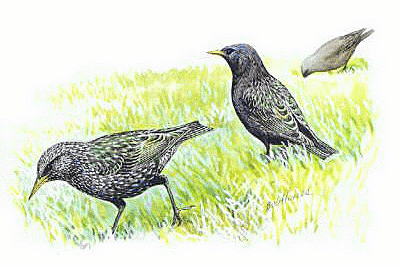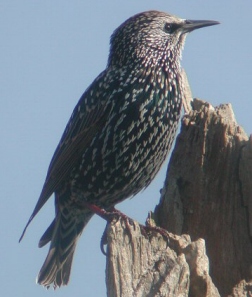|
Small, chunky,
iridescent purple and green blackbird with long, pointed
yellow bill, pink legs, and short tail.
The feathers on back and undertail
show buff edges. Feeds in open areas, normally on the ground.
Strong, direct and swift flight on
rapidly beating wings.
The breeding adult European Starling
is an iridescent purple and green black bird with white flecks overall.
The bill is yellow with a blue base in males,
a pink base in females.
|
EUROPEAN
STARLING
Sturnus vulgaris
PASSERIFORMES
Starling (Sturnidae)
Range and Habitat
Native to Eurasia, but widely introduced worldwide. Occurs from Alaska
and Quebec south throughout the continent to the Gulf coast and northern
Mexico. Preferred habitats include cities, suburban areas, farmlands,
and ranches.
SOUND: "pheeEW"
All of the 200 million European Starlings found in North
America today are descendants of approximately 100 birds released in
New York City's Central Park in the early 1890s by an industrialist
who wanted to establish, in the U.S., all birds mentioned in the works
of Shakespeare.
They compete aggressively for nesting sites and may
evict the occupants of desired holes, including the
woodpeckers that excavated them.
An individual bird can mimic up to 20 species, including Eastern Wood
Pewee, Killdeer, and Meadowlark songs.

A group of starlings has many collective nouns,
including a "constellation", "filth", "murmuration",
"scourge", and "vulgarity" of starlings.
The European Starling is also referred to as the Common Starling. This
bird species is rated at this time as Least Concern. In 2000, the European
Starling was rated as Lower Risk. The Lower Risk rating was downgraded
due to the population and range of this bird species. The European Starling
has a range of about 10 million kilometers.

|